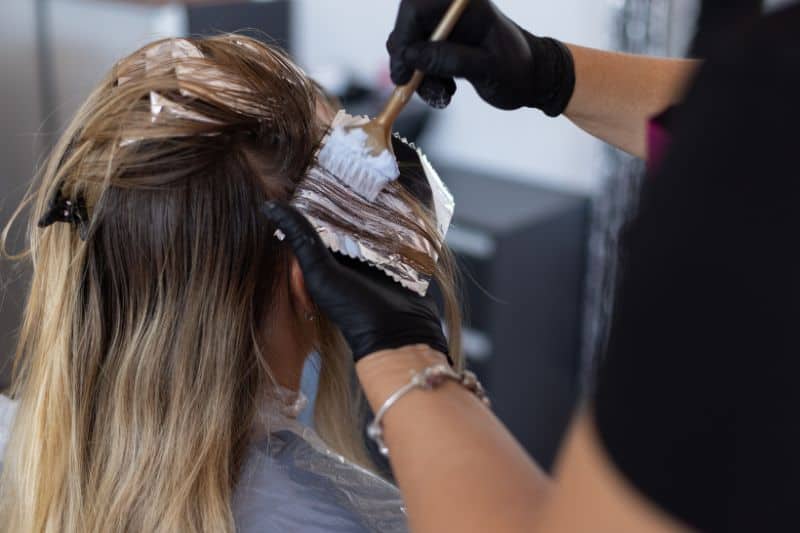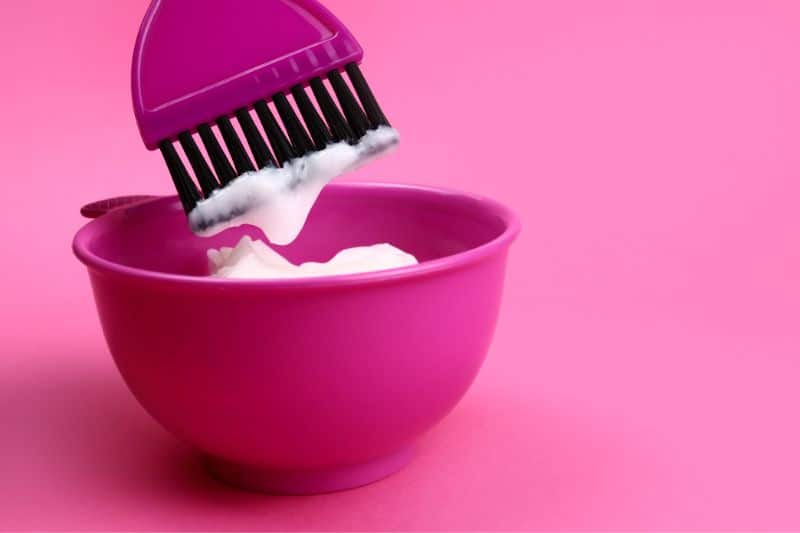More regularly than they would care to admit, people color and bleach their hair. The procedure for bleaching or dyeing hair requires many stages and can produce much trash, whether it is carried out in the house or a salon. It is difficult to know how to get rid of hair bleach, specifically in an eco-friendly manner.
Most individuals must know how to properly remove hair bleach and dump it in the garbage or the bathroom sink. The proper disposal of waste is important since a mistake could cause significant environmental harm. Here are some suggestions for properly discarding hair colors and bleach.
Various Ways To Dispose of Hair Bleach
Getting rid of hair bleach properly is crucial to ensure that it does not affect the environment or people. You can safely dispose of hair bleach by the methods listed below:
1 Diluting Hair Bleach
Dumping the bleach into the kitchen sink or bathroom drain could dilute it with water. Turn on the faucet, then dump the bleach down the drain slowly while the water flows until the receptacle is empty. Let the water run for at least one minute before shutting the faucet off after all the bleach has been poured down the drain.
Additionally, you have the option of flushing bleach into the toilet. Do this, nevertheless, only with modest doses of bleach. Additionally, it would be best if you flushed twice or thrice to guarantee it is well diluted. Because doing this can still affect aquatic life, only do it if you are unwilling to reuse or give.
2. Donate It
Do you have any unopened hair coloring bottles lying around your house? You can give them to a medical residence or a facility for assisted living if you are certain you will not utilize them. The dye bottle can also be given to a local long-term care facility or women’s shelter. They might apply it to their tenants’ hair to color it.
You will avoid the hassle. Furthermore, nothing compares to the fulfilling sensation of knowing that you have just brightened someone else’s day! Just be careful to look for local facilities that are prepared to accept such things. This is because many facilities, even those that are sealed, still need to receive such products.
3. Hazardous Waste Facility
Facilities for handling hazardous waste are created to safely dispose of things detrimental to the natural world or persons. These facilities may handle hair bleach and additional substances for appropriate chemical disposal. Suppose you have questions about the products they accept or the disposal procedure.
In that case, you can contact your neighborhood hazardous waste facility or the waste management division of your local government. In some circumstances, you could be obliged to transport your hazardous trash to a certified drop-off location, while the facility might also provide collection services in other situations.
To save the environment and avoid accidents, hazardous substances, such as hair bleach, must be disposed of correctly. If you need help with safely disposing of hair bleach or similar hazardous items, get advice from your neighborhood hazardous waste center.
4. Find a Household Waste Program
Giving it to the household waste program is an excellent alternative to eliminating unneeded or extra hair dye. Contact them to find out if your township or other local governments are running such initiatives.
You can drop off the extra or unwanted hair bleach at that facility if they offer such a service. This will guarantee that the dye is utilized and not wasted. If your neighborhood does not have one, you can find a hazardous waste disposal facility nearby to remove the dye.
5. Use Natural Hair Dyes
Organic and plant-based hair bleach is the best option to avoid working with harmful chemicals. Consider using henna, a natural hair dye that nourishes hair and adds shine and volume. Henna would be an excellent alternative hair color for dreadlocks.
Additionally, you can securely dispose of any leftover henna by including it in the compost heap rather than the garbage if you have any. Remember also to condition your hair well after using henna on it! The color will only last briefly if you choose oil or shampoo instead of henna.
Lemon or grapefruit juice can be added to the henna dye. Henna, though, is infamous for being messy. Purchase of one of the numerous plant-based hair colors, which utilize fewer potentially hazardous chemicals, is a simpler option. These organic hues are less harmful to both the earth and your hair.

How Long is Hair Bleach Good For?
Usually, bleach for hair has a two-year shelf life. Before using it, it is crucial to verify its expiry date. Utilizing outdated hair bleach may be risky. Your hair might get damaged, and it might not grow correctly. When bleach is exposed to light, it swiftly degrades. It lasts for around 20 minutes before losing its potency.
If the product includes developer, bleach powder, or other chemicals, its shelf life may be significantly affected. Developer and Bleach powder are typically included in various hair bleach formulas. Since different manufacturers make varying claims about how long their items will survive, it can take much work to provide an exact shelf life.
Hair bleach has a limited shelf life once the packaging has been opened. Under certain conditions, hair bleach might expire within six months. The expiration date, however, may alter depending on if the product contains bleach solution or other regularly used chemicals, so you must carefully check the product label.
An untouched hair dye container may appear in perfect condition for the inexperienced eye and nose. However, there are indicators that it might have gone wrong, such as an unusual hue and odor, a broken or dripping bottle forming a cake-like structure to go around the bottle’s top, and damaged, fading, or dented packaging.
What To Do With Leftover Hair Bleach?
If you frequently alter the hair color on your head, you have undoubtedly undergone bleaching at least a few times. You also know that bleaching is frequently a necessary stage in hair coloring.
However, you should not be concerned if you color your hair in a salon. Your colorist will dispose of the residual product by disposal regulations. However, without assistance, things change if you bleach your hair at home alone.
Need help with how to use the remaining hair bleach? The following choices may be suitable for you:
- Employ it as a disinfectant: You can use bleach to clean surfaces throughout the house and as a powerful disinfectant.
- Clear Drain Clogs: Would you believe that hair bleach may additionally clear drain clogs? Put it directly into the drain and flush it with hot water after sitting for 15 minutes.
- Create Your Disinfectant Wipes: Should you have any old rags hanging around, cut them into little squares and soak them in a bleach solution to make DIY disinfectant wipes. You already have your homemade disinfecting wipes.
- Remove Stains: What caused the stain? Pour a little bleach on the stain and watch it vanish as you eliminate it.
- Cleaning The Toilet: Is your toilet filthy? Add half a cup of bleach to the toilet for a spotlessly clean toilet bowl, and let it soak for 30 minutes before flushing.
Can You Throw Hair Bleach Down The Drain?
If diluted with lots of water and kept separate from other chemicals, hair bleach can be thrown away down the drain. Pouring hair bleach into the toilet can harm septic systems; thus, it is not advised. In addition, it can harm aquatic life and destroy helpful microorganisms crucial for degrading trash.
It is recommended to contact a neighborhood hazardous waste disposal business if you have worries about the environment to figure out how to dispose of your extra bleach properly. Never flush hair coloring down the toilet. This is so because the materials used to make these dyes include synthetic chemicals and other things that are considered hazardous waste.
The numerous chemicals utilized to create synthetic colors can potentially harm our ecosystem. For instance, phenylenediamine, or PPD, is a component in hair dyes to correct shade. Fish and other creatures are fatally affected by this toxic chemical. Additionally, it may drastically harm soil and water.
Hair dyes washed down the drain have a good chance of contaminating your water supply. Workers at disposal facilities will find it challenging to filter these pollutants from the water. They frequently make the water poisonous and useless.
Is Hair Bleach Toxic/Hazardous Waste?
Although technically not harmful, hair bleach can be categorized as containing dangerous substances. This indicates that it must be removed in a specified manner to protect the environment and you. Hydrogen peroxide and ammonia, the components of hair bleach, are regarded as harmful waste.
If these substances are disposed of in the trash, the ecosystem could suffer significant damage. They can easily explode and pollute the earth’s water supply if not properly disposed of. Therefore, getting rid of hair bleach is crucial in a technique that’s both secure and kind to the earth.
Conclusion
If you fail to take the right measures, bleaching your hair yourself can harm both you and the environment. Since bleach is dangerous and corrosive, you must take the proper precautions when removing it.
If handled improperly, peroxide-based hair bleach is toxic and can harm the hair and the scalp. The key to getting the hair color you want is to follow the bleach kit directions carefully; otherwise, harm may result from leaving bleach in the hair for a lengthy period.






